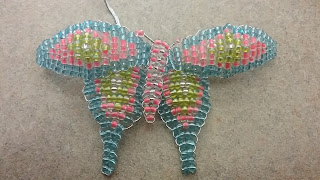The something I decided to do was teach an entire class of my high school students about beadwork. Remember those adorable little dragonflies/butterflies? They all made one.
For our last few weeks of the final semester before summer vacation, the alternative high school where I teach does something a little different. Called a "Skinny," it eschews typical academic classes (except for online or credit recovery) and offers a more authentic experience of learning. In one group they learned to change a tire. In another they learned how to cook. I've taught sewing in the past, as well as a whole session entitled "Monsters and Myths." I'm afraid I've inspired an entire group of future Stephen King writers or Alfred Hitchcock directors.
We started small since most students had never even attempted beadwork. I seriously budgeted time for the first lesson, as I thought I might have to keep them from getting distracted with breaks or other amusements. I am amusing most times. But after a brief lesson about the historical significance, each and every student shocked me...
Every kid the entire hour worked. I offered a break and they refused. I offered my usual amusement and they shooed me away as a distraction. Little did I know that this hands-on class of Victorian beading would sweep the school! Soon students from other classes filed into my room for a taste of the beading life. And like the first budding of spring, trembling butterflies and dragonflies emerged...
There are many more than this, but unfortunately they flew away before I had a chance to capture their likeness! I had one student in particular use the butterfly for another purpose. As her mother suffered from lupus, she decided to make a butterfly in purple to match lupus awareness. This one actually got me a bit choked up.
Towards the end of the semester I actually had a former student come in to teach a class on a bead loom. Remember those adorable beaded bracelets I make? After another historical lesson I made each kid a wooden loom and brought Tristen in to teach. Her family owns a very awesome craft store in the area, so she really knows her stuff. It went well and there are 10 billion beads all over my room. Also, a special shout out to Kay Cogswell, who originally designed that first loom for her workshop at Genteel Arts last year. I wouldn't have been able to afford this project otherwise!
You may be wondering how this all fits together with the blog. Well I discovered that a group of youngsters that had shown no previous inclination to history really enjoyed learning about history. Except with their hands, rather than in a lecture format. Our discussion of tremblers led to a discussion about bonnets, which led to a discussion about 19th century customs, which led to a discussion about morals and values of a different time period. I stepped back from my role as a teacher to become an actively quiet facilitator, fanning the occasional interested student if the quiet lingered too long. For the first time in awhile, I really felt like a teacher.
How can you use this information, you history-loving person? You, the member of a historical society looking to create a youth program. You, the reenactor looking to create a younger membership base. You, the parent frustrated by your child's lack of interest in history.
Let me give you an advice list, compiled by my own trial and error:
1. Don't assume kids hate history. THEY DON'T. They hate sitting in a classroom for hours. They hate memorizing facts. They hate tests and quizzes and trifold boards. A poorly-run classroom setting can beat the passion out of a child (Side note: I don't do tests/homework in my class) They enjoy eating campfire food, climbing trees, firing cannons, riding horses, and all sorts of other nonsense.
2. Give them chances to fiddle. To inspect closely, examine the details. To break something or cut it to pieces. You know that cannon your child keeps staring at? Get up close. Talk to the unit in charge of it. If possible, let your child touch it, understand the process. And if you're crazy enough, soon enough he/she will want one for the front yard...
3. Make moments teachable. That kid who just plays video games all day (ahem, I do find myself trapped in a Mech Warrior cycle...)? Relate it in some way to hands on history and watch them explore. What was the precursor to the modern computer? How did people originally sum large numbers without a calculator? What is the 19th century equivalent of Facebook?
The discussion about butterflies went so many places!
As for my class...it was awesome, and I'm so happy I did this. Despite the huge mess and pile of disorganized beads, I want to do it again. More importantly, the kids want to as well. I hope you can take a bit of my advice and find a way to further bring young people into history. If all else fails, candy works too :)
~Kristen












No comments:
Post a Comment